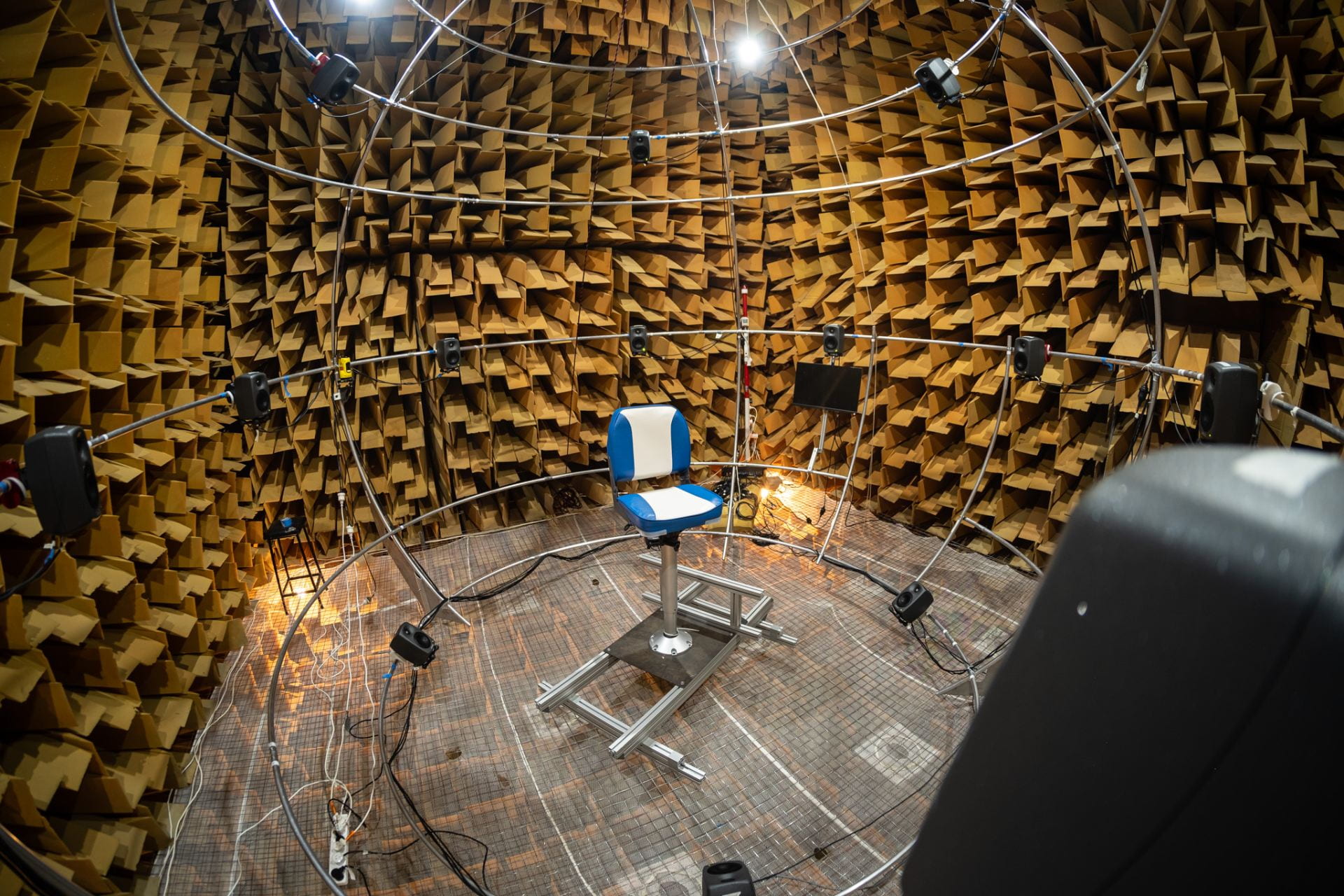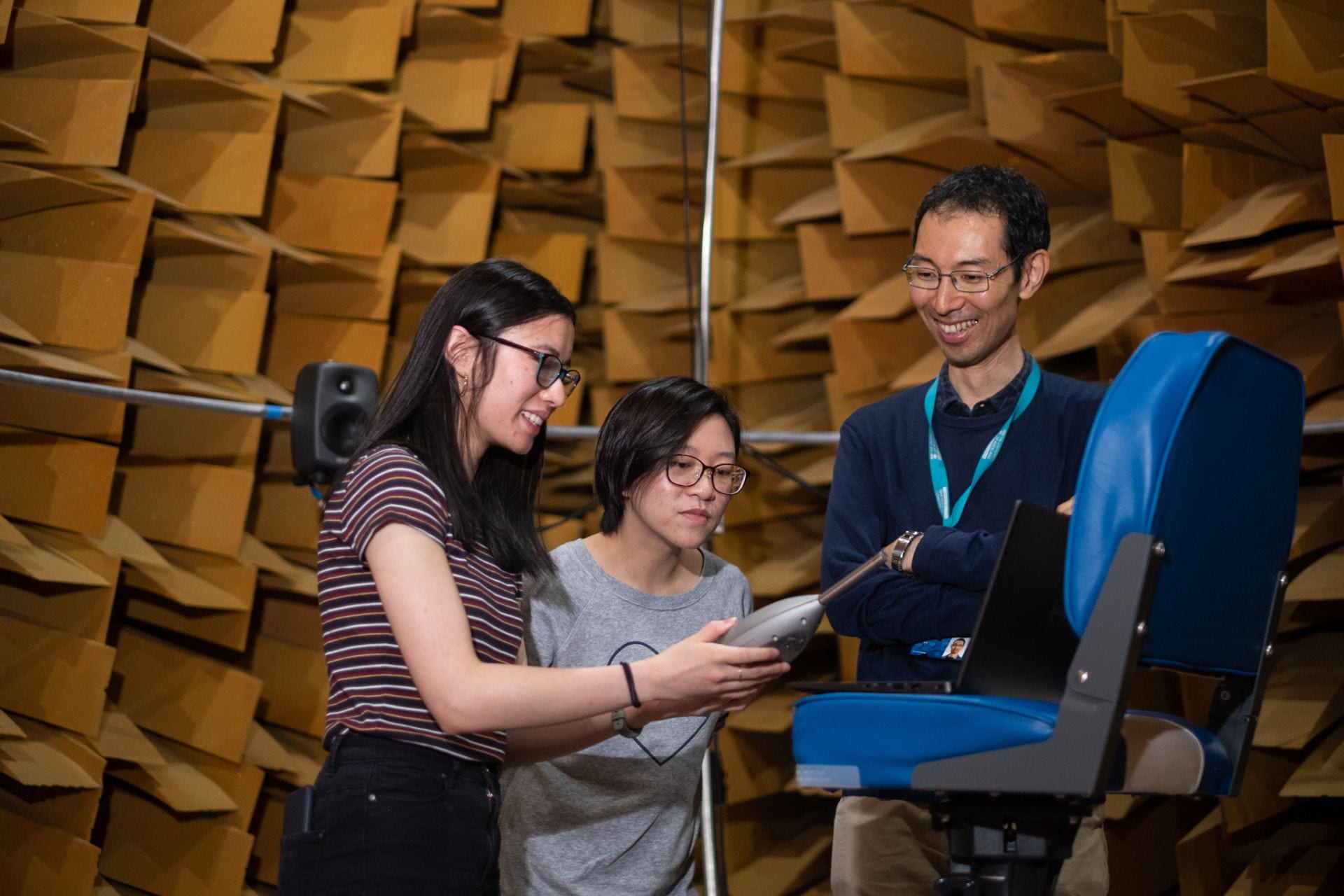Research
Effect of noise and room acoustics on the speech intelligibility of non-native listenersHow well we can understand speech is largely affected by both internal factors (our language proficiency and hearing abilities), and external factors such as noise and reverberation in our surrounding environments. While it is well known that these spatial acoustics such as noise and reverberation affect speech intelligibility (how well we can understand speech), it has not always been easy to test this in a controlled, scientific manner. To address this, a sound reproduction system (SRS) within the anechoic chamber has been developed to simulate real-world acoustic environment, allowing listeners to hear as if they were in different rooms.
The current project aims to utilise this sound reproduction system to examine how speech perception can differ depending on the acoustic environment (e.g. in a lecture hall versus a church), with listeners of different language proficiency.
As the world becomes more and more multi ethnic and multi-lingual, it becomes an equity issue where people have a right to access information regardless of their language background. To this end, we will reveal and quantify how the ambient acoustic environment of a listener affects the understanding of speech for non-native listeners at different level of proficiency. Ultimately, we want to establish solid guidelines for room acoustics as well as audio signal processing to help non-native listeners with better communication experiences.


Publications/conference presentations relevant to this research
Journal articles/Book chapters
- Y. Hioka, C.T.J. Hui, H. Masuda, Y.C. Zhang, E. Osawa, and T. Arai. Using spatial sound reproduction for studying speech perception of
listeners with different language immersion experiences. Speech Communication, 175:103320, 2025. Open access link - C.T.J. Hui, H. Masuda, E. Osawa, T. Arai, C.I. Watson, and Y. Hioka. Role of language familiarity in understanding speech in noise under various acoustic environments. Speech Communication, 169, 103195, 2025. Open access link
- C. T. Justine Hui, H. Masuda, Y. Hioka, C.I. Watson. Word identification of New Zealand English by native Japanese listeners with and without exposure to New Zealand English. Acoustical Science and Technology, 44(1), 29-32, 2023. Open access link
- C.T. Justine Hui, Y. Hioka, H. Masuda, and C.I. Watson. Differences between listeners with early and late immersion age in spatial release from masking in various acoustic environments. Speech Communication, 139, 51-61, 2022. Publisher’s link
- C.T. Justine Hui, E. Au, S. Xiao, Y. Hioka, H. Masuda, and C.I. Watson. Differences in speech intelligibility in noise between native and non-native listeners under ambisonics-based sound reproduction system. Applied Acoustics, 184, 108368, 2021. Publisher’s link
- E. Osawa, C.T. Justine Hui, Y. Hioka, and T. Arai. Effect of prior exposure on the perception of Japanese vowel length contrast in reverberationfor nonnative listeners. Speech Communication, 2021. Publisher’s link
- E. Au, S. Xiao, C.T. Justine Hui, Y. Hioka, H. Masuda, and C.I. Watson. Speech intelligibility in noise with varying spatial acoustic sunder Ambisonics-based sound reproduction system. Applied Acoustics, 174, 107707, 2021. Publisher’s link
Conference proceedings
- Y.C. Zhang, D. Jagmohan, H. Li, C.T.J. Hui, and Y. Hioka. Effect of noise floor in room impulse response on speech perception under spherical harmonics-based spatial sound reproduction. In Interspeech 2025, pp.928-932, Aug 2025. Conference proceedings link
- Y. Hioka, C.T.J Hui, H. Masuda, C.I. Watson, E. Osawa, and T. Arai. Spatial audio reproduction for studying second language speech perception in varying acoustic environments. Internoise 2023.
- Y. Hioka, C.T.J Hui, Y.C. Zhang, A. D’Souza, and K. Wu. Differences in speech intelligibility in noise under Ambisonics-based virtual acoustic environments with varying sound recording/rendering methods. Internoise 2023.
- Y. Hioka, C.T. Justine Hui, H. Masuda, C.I. Watson. Effect of room acoustics on speech intelligibility under noise between native and non-native listener. NOVEM2023.
- C.T. Justine Hui, Y. Hioka, H. Masuda, and C.I. Watson. Spatial release from masking in varying spatial acoustic under higher order Ambisonic-based sound reproduction system. Internoise 2021. (Presentation video)
- C.T. Justine Hui, H. Masuda, Y. Hioka and C.I. Watson. Speech intelligibility of New Zealand English by native Japanese listeners. LangSoc2020. (Presentation video)
- C.T. Justine Hui, E. Au, S. Xiao, Y. Hioka, H. Masuda, and C.I. Watson. Benefit from spatial release from masking for native and non-native listeners in simulated room acoustics. Internoise 2020. (Presentation video)